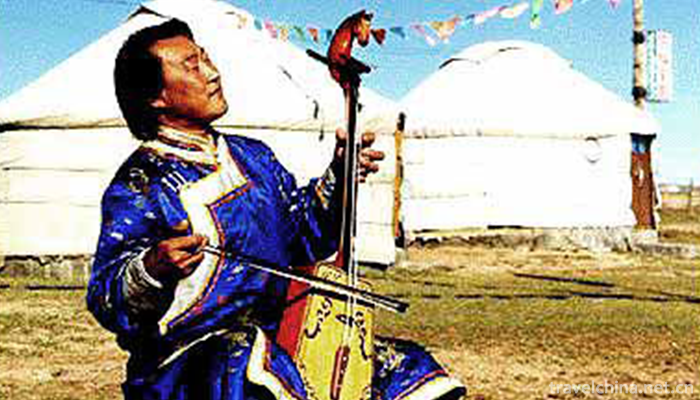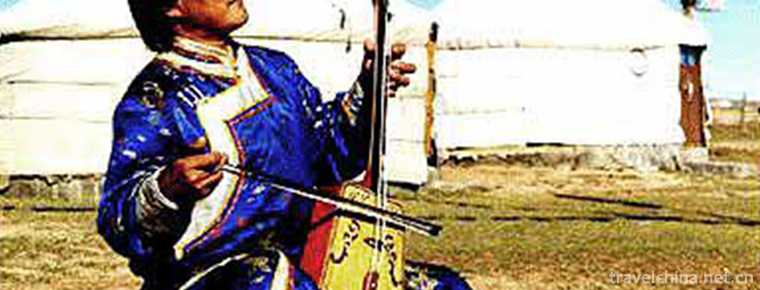Mongolian Matouqin Music
Mongolian Matouqin Music
Horsehead Qin is a typical representative of Mongolian music culture. Whether it is its shape, production material, sound quality, timbre, music expression style and performance method, it embodies the connotation of Mongolian personality, fully reflects the historical form of Mongolian nomadic life, and expresses Mongolian thinking and understanding of natural cosmos philosophy.
May 20, 2006 was listed in the first batch of national intangible cultural heritage list.
historical origin
The Mongolian horsehead piano has a long history. During the formation of the Mongolian nationality, the Horsehead piano already existed. In the long-term development of history, Horsehead Qin has formed different schools with distinct regional color, which are closely related to the internal and external convergence and separation of Mongolian and historical changes. It can be said that the Horsehead Qin accompanies the Mongolian people from the grassland and the historical distance, which carries rich historical and cultural information.
artistic characteristics
Horsehead piano not only plays on some formal and grand occasions, but also appears in folk wedding ceremonies, family and friends gatherings and other daily activities. It can be used as accompaniment to songs, as well as solo repertoire. The horsehead piano has a profound social and folk tradition foundation, and plays the social functions of disseminating culture, cultivating sentiment, changing customs and customs.
Representative works
The traditional repertoire of Ma Tou Qin evolves from folk songs, which can be divided into five categories: 1. Native folk songs, such as "Zhu Se Love" and "Ba Ya Ling"; 2. Heroic epic melodies, such as "Running Horse Tune" and "Battle Tune"; 3. Horse pace, that is, the melody expressing the image of horses; 4. Qin melodies developed from folk songs, such as "Lotus Flower" and "Modley"; 5. Ancient Han melodies, such as "Pu'an Mantra" 》 Liu Qingniang, etc.
Inheritance significance
Horsehead Qin is highly respected in Mongolian culture and has become a very important manifestation of Mongolian culture. In recent decades, the development of horsehead piano has encountered serious difficulties. There are four traditional schools of horsehead piano in history, each of which has its own traditional repertoire. But up to now, the inheritance of horsehead piano is becoming scarce, and the loss of repertoire is serious, so it is urgent to protect it.


-
2.Noodles with Soy Bean PasteBeijing Style
Old Beijing fried noodles, a traditional Chinese pasta, made from dishes, fried sauce mixed noodles, popular in Beijing, Hebei, Tianjin and other places.
Time 2018-10-27 -
3.Gold medal suckling pig
Roasted Suckling Pig. Characteristic: It has won the "Golden Ding Award" by the national commercial department. It is a precious Cantonese dish at the banquet.
Time 2018-11-14 -
4.Tianjin Ancient Culture Street Tourist Area Jinmen Hometown
Tianjin Ancient Culture Street is located outside the east gate of the northeast corner of Nankai District of Tianjin City and on the West Bank of Haihe River
Time 2018-11-24 -
5.Expo Area of Acient Kiln & Folk Cultures in Jingde
Jingdezhen Ancient Kiln Folklore Expo Area, located in Fengshu Mountain and Panlonggang, Changjiang District, Jingdezhen City, Jiangxi Province
Time 2018-12-08 -
6.Legend of White Snake
Legend of White Snake, local traditional folk literature in Zhenjiang City, Jiangsu Province and Hangzhou City, Zhejiang Province, is one of the national intangible cultural heritage.
Time 2018-12-15 -
7.Central Radio and Television Tower
The Central Radio and Television Tower, now a national 4A scenic spot, is located on the west side of West Third Ring Road, Haidian District, Beijing. Near the Space Bridge, it faces beautiful Yuyuant
Time 2018-12-22 -
8.Shaanxi History Museum
Shaanxi History Museum, China's first large-scale modern national museum, the first batch of China's "AAAA" class tourist attractions, known as the "ancient capital pearl,
Time 2019-02-08 -
9.ancient game of kicking a ball
Cuju, also known as "Biju", "Cuju", "Cuju", "Cuyun", "Cuyun", "building a ball" and "kicking a round", has the meaning of "Cu
Time 2019-04-22 -
10.Forty eight Zhai Song Festival
The forty-eighth Village Song Festival is a northern Dong dialect Song Festival in Tianzhu County, Guizhou Province, China. It is a traditional national festival featuring Dong
Time 2019-05-01 -
11.Ningbo Gold and Silver Embroidery
Ningbo gold and silver embroidery is one of the Han folk handicraft products embroidered on silk fabrics with various color threads, gold threads and silver threads. With its strong local characterist
Time 2019-06-07 -
12.Laozi Shandong Province
Shandong Laozi is a traditional opera art form which spreads in Shandong Province. It evolved from the ancient "lotus flower falls". Laozi instruments are mainly cymbals (commonly known as G
Time 2019-06-13